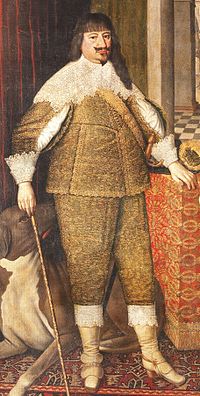Treaty of Stettin (1630)
[4] After the death of the last Pomeranian duke in 1637, forces of the Holy Roman Empire invaded Pomerania to enforce Brandenburg's claims on succession, but they were defeated by Sweden in the ensuing battles.
[7] Following the Capitulation of Franzburg in 1627, the Duchy of Pomerania was occupied by forces of Ferdinand II, Holy Roman Emperor, under command of Albrecht von Wallenstein.
[11] The Danish campaigns in Pomerania and other parts of the Holy Roman Empire ended with the Battle of Wolgast in 1628 and the subsequent Treaty of Lübeck in 1629.
[13] The Truce of Altmark ended the Polish–Swedish War (1626–1629) in September 1629, releasing the military capacities needed for an invasion of the Holy Roman Empire.
The core of the invasion force consisted of trained peasants, recruited to the Swedish army following Gustavus Adolphus' military reforms of 1623.
[23] The treaty also included the alliance with Stralsund of 1628, which was concluded when the town resisted the Capitulation of Franzburg and was thus besieged by Albrecht von Wallenstein's army.
[2] The Swedish king and the high-ranking officers were given absolute control over the duchy's military affairs,[nb 6] while the political and ecclesial power remained with the dukes, nobles, and towns.
[17] The amending treaties were necessary because the Pomeranian nobility had insisted on having the shift in military control of the duchy to Sweden separate from the Swedish-Pomeranian alliance.
When Bogislaw XIV, Duke of Pomerania had concluded the alliance, he immediately wrote a letter to Ferdinand II, Holy Roman Emperor, reading "This union is not directed against the majesty of the Emperor or the Empire, but is rather designed to maintain the constitution of the Empire in its ancient state of liberty and tranquillity, and to protect the religious and secular settlements[nb 3] against the ravagers and disturbers of the public peace, and thereby not only to leave intact the relationship which binds us, Bogislaw XIV [...] to His Imperial Roman Majesty [...] but also to preserve our lawful duty and obligations to the same.
[26] Yet, Ferdinand II did not forgive Bogislaw XIV, and instead the imperial occupation forces in Pomerania were instructed to act even more harshly.
[27] With the aforementioned treaties, Sweden included the Pomeranian duchy in her military contributions' system, enabling her to triple the size of her forces there within a short period.
[2] Gustavus Adolphus of Sweden even returned from Brandenburg to supervise the siege, and upon his arrival received the university's homage for the liberation.
[2] While the Swedish king issued several decrees[nb 8] ruling and restricting the interaction of soldiers and burghers,[2] this did not prevent "turmoils against the undisciplined soldatesca" already in 1632.
[30] While these obliged George William, Elector of Brandenburg to hand over control of the Brandenburgian military to Sweden, he refused to enter an alliance.
[28] When a fire destroyed what was left of the town, and 20,000 inhabitants were burned, the Protestants' scepsis turned into support for the Swedish king.
[34] This defeat of the combined imperial and Catholic League forces allowed Sweden to pursue deep into Central and Southern Germany.
[24] After Sweden had to acknowledge her first serious defeat in the Battle of Nördlingen (1634), Ferdinand II, Holy Roman Emperor and several Protestant states concluded the Peace of Prague in May 1635.
[36] Another consequence of the lost Battle of Nördlingen was that large parts of the Swedish army, including thousands of injured, retreated to Pomerania, followed by imperial forces who entered the duchy in 1636.
[37] In 1637, a capitulation was issued that mentions "irruption" and "insolentia" by the military, and ruled out more drastic consequences for irregular behaviour of the soldiers.
[38] Swedish legate Sten Svantesson Bielke[nb 7] on 11 March advised the Pomeranian council to nevertheless adhere to the Alliance of Stettin, and to reject any Brandenburgian interference.
[38] George William, Elector of Brandenburg, in turn mailed Christina of Sweden on 14 March to respect his succession in the Pomeranian duchy based on the treaties of Pyritz (1493) and Grimnitz (1529), on which the alliance did not have any impact.
[38] The same day, a courier arrived in Stettin with the elector's seizure patent, who at once was incarcerated by Bielke and threatened with death by hanging.
[6] The same month, emperor Ferdinand II gave the duchy of Pomerania to Brandenburg as a fief, which was accepted by the nobility on 26 January.
[40] Johan Nicodemi Lilleström was appointed to draft a schedule for the final integration of Pomerania into the Swedish Empire.
[43] When peace talks started in Osnabrück to end the Thirty Years' War, a Pomeranian delegation was present in early 1644 and from October 1645 to August 1647.
[45] Swedish-Brandenburgian negotiations about the definite frontier started in early 1650,[46] resulting in another Treaty of Stettin which defined the exact border on 4 May 1653.







